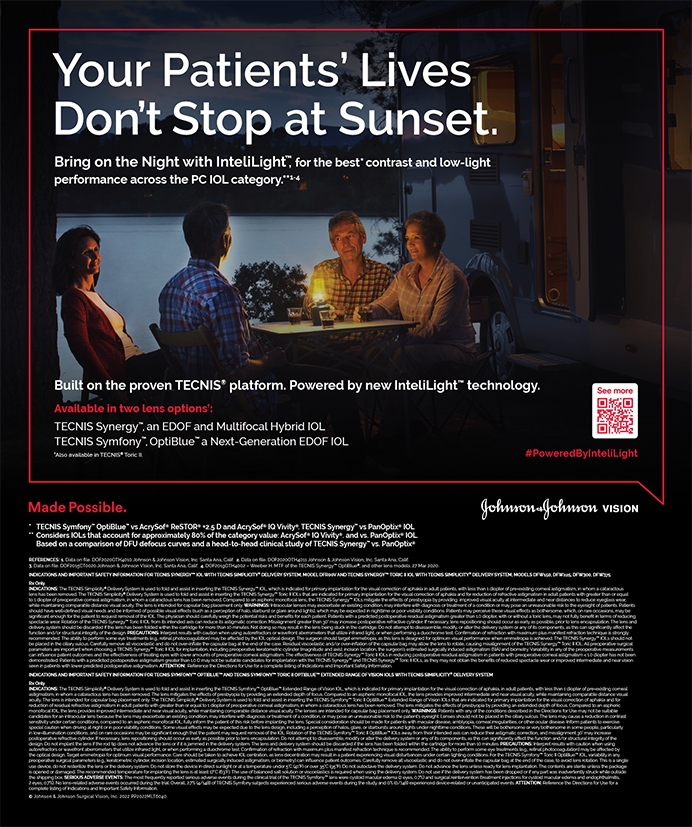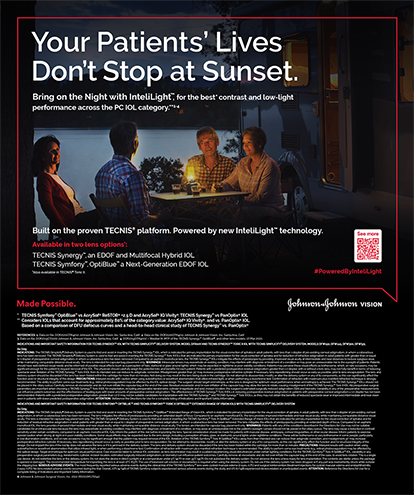
Comparative Visual Outcomes of EDOF Intraocular Lens With FLACS vs Conventional Phacoemulsification
Xu J, Li W, Xu Z, et al1
Industry support: None
ABSTRACT SUMMARY
Investigators randomly assigned 261 eyes of 261 patients to either femtosecond laser–assisted cataract surgery (FLACS) with the LenSx Laser (Alcon) and a 5-mm capsulotomy setting (n = 131 eyes) or conventional phacoemulsification with a manual continuous curvilinear capsulorhexis (CCC; n = 130 eyes). All patients received an extended depth of focus (EDOF) IOL (Tecnis Symfony, Johnson & Johnson Vision). The investigators evaluated clinical outcomes 3 months after surgery, including IOL decentration and tilt, wavefront aberrations, visual acuity, refractive outcomes, defocus curve, and contrast sensitivity. Responses to a patient questionnaire were also evaluated.
Study in Brief
A prospective cohort study of eyes that received an extended depth of focus IOL compared quality of vision after femtosecond laser-assisted cataract surgery versus conventional phacoemulsification. The size and shape of the capsulotomy, IOL centration, and visual performance were better in the laser group.
WHY IT MATTERS
This is the first published study to compare the results of laser cataract surgery and conventional phacoemulsification in patients who received an extended depth of focus IOL.
No significant differences in postoperative visual acuity or spherical equivalent at distance, intermediate, and near were found between groups. Compared to the conventional phaco group, the FLACS group experienced a significantly lower incidence of IOL decentration and tilt and significantly lower total aberration, higher-order aberrations, coma, and spherical aberration. The FLACS group also had a better defocus curve and higher contrast sensitivity.
DISCUSSION
The integration into femtosecond laser systems and operating microscopes of diagnostic devices such as the IOLMaster 700 with Veracity Surgical and Callisto eye (all from Carl Zeiss Meditec) and the Argos biometer with the Verion Image Guided System and ORA (all from Alcon) can improve workflow and patient outcomes. One factor influencing the success and accuracy of cataract surgery is the capsulotomy. A well-centered and appropriately sized capsular opening is required to prevent IOL tilt and decentration, both of which can reduce the quality and quantity of vision after surgery.2,3 Optical aberrations from a tilted or decentered IOL can affect retinal image quality4 and cause glare and halos, all of which can increase patients' risk of falls and hamper the activities of daily living.5,6 These issues are of greater concern with toric, EDOF, and multifocal IOLs because they are more sensitive to off-axis rotation and malpositioning than spherically neutral monofocal lenses.7-9
Many studies have compared the results of FLACS and conventional phacoemulsification,10,11 but this is the first to discuss results in patients who received an EDOF IOL. No significant difference in intra- and postoperative complications was found between the study groups. In the FLACS group, however, visual outcomes were better, and the IOL was less likely to become decentered or tilt over time owing to better capsular overlap.
Parameters of Capsulorrhexis and Intraocular Lens Decentration After Femtosecond and Manual Capsulotomies in High Myopic Patients With Cataracts
Zhu Y, Shi K, Yao K, et al12
Industry support: None
ABSTRACT SUMMARY
Investigators compared capsulotomy parameters and IOL decentration in eyes in which the capsular opening was created with a femtosecond laser versus those in which the opening was made manually. The study included 142 eyes of 108 patients with high myopia, cataract, and an axial length of at least 26 mm. The FLACS group was treated with the LenSx Laser and a capsulotomy setting of 5 mm. A 5-mm CCC was targeted for the conventional group.
Study in Brief
A prospective, consecutive, nonrandomized cohort study compared capsulotomy parameters and IOL decentration in the eyes of patients with cataracts and high myopia in which the capsular opening was created either with a femtosecond laser or manually. When the anterior chamber depth was greater than 3 mm, better centration and sizing were achieved in the laser group. Long-term IOL centration was also better in the laser group owing to a more precise capsulotomy size and better capsule-IOL overlap.
WHY IT MATTERS
The prevalence of myopia has increased dramatically worldwide during the past few decades. Patients with high myopia tend to develop cataracts earlier than emmetropic patients, and the former often have enlarged capsular bags and weak zonules, which increases the risk of IOL decentration.
Anterior segment photography was performed 1 week, 1 month, and 2 years postoperatively to measure the capsulotomy’s circularity, centration, and overlap of the IOL. The size of the laser capsulotomy was consistently 5 mm, whereas the manual CCC was larger at each measured time point. Circularity and centration were also better with the laser capsulotomy compared to the manual CCC.
In the study, the laser capsulotomy held advantages over the manual CCC when the anterior chamber depth was greater than 3 mm. This was due to significant differences in the pupil reference and operating angle, which caused difficulty with the manual CCC. No statistical difference between groups was observed when the anterior chamber depth was less than 3 mm. Because of superior capsule-IOL overlap and a more precise capsulotomy size, IOL centration was better at 2 years in the FLACS group when the anterior chamber depth was greater than 3 mm.
DISCUSSION
High myopia is the most common risk factor for advanced intracapsular IOL dislocation.13 A 2018 study found a significantly higher rate of IOL tilt and decentration in these eyes compared to those with cataract but not myopia.14 The study by Zhu and colleagues12 provides insight into the impact of FLACS on capsulotomy parameters and IOL decentration in patients with high myopia and cataract. The superior circularity and centration of the laser capsulotomy compared to the manual CCC observed in the study are in line with previously reported findings.15,16
High myopia causes unique pathologic changes, including deepening of the anterior chamber, that make the creation of a perfectly circular and properly sized capsulotomy especially important. The study by Zhu et al12 adds to a growing body of evidence supporting the use of FLACS in these challenging eyes.
1. Xu J, Li W, Xu Z, et al. Comparative visual outcomes of EDOF intraocular lens with FLACS vs conventional phacoemulsification. J Cataract Refract Surg. 2023;49(1):55-61.
2. Miret JJ, Camps VJ, García C, Caballero MT, de Fez D, Piñero DP. New method to improve the quality of vision in cataractous keratoconus eyes. Sci Rep. 2020;10(1):20049.
3. Hahn U, Krummenauer F, Schmickler S, Koch J. Rotation of a toric intraocular lens with and without capsular tension ring: data from a multicenter non-inferiority randomized clinical trial (RCT). BMC Ophthalmol. 2019;19(1):143.
4. Chen X, Gu X, Wang W, et al. Characteristics and factors associated with intraocular lens tilt and decentration after cataract surgery. J Cataract Refract Surg. 2020;46(8):1126-1131.
5. Nikitovic M, Brener S. Health technologies for the improvement of chronic disease management: a review of the Medical Advisory Secretariat evidence-based analyses between 2006 and 2011. Ont Health Technol Assess Ser. 2013;13(12):1-87.
6. Khan S, Rocha G. Cataract surgery and optimal spherical aberration: as simple as you think? Can J Ophthalmol. 2008;43(6):693-701.
7. Xu CC, Xue T, Wang QM, Zhou YN, Huang JH, Yu AY. Repeatability and reproducibility of a double-pass optical quality analysis device. PLoS One. 2015;10(2):e0117587.
8. Xu J, Zheng JT, Lu Y. Effect of decentration on the optical quality of monofocal, extended depth of focus, and bifocal intraocular lenses. J Refract Surg. 2019;35(8):484-492.
9. Ruiz-Alcocer J, Martínez-Alberquilla I, Rementería-Capelo LA, De Gracia P, Lorente-Velázquez A. Changes in optical quality induced by tilt and decentration of a trifocal IOL and a novel extended depth of focus IOL in eyes with corneal myopic ablations. J Refract Surg. 2021;37(8):532-537.
10. Schweitzer C, Brezin A, Cochener B, et al; FEMCAT study group. Femtosecond laser-assisted versus phacoemulsification cataract surgery (FEMCAT): a multicentre participant-masked randomised superiority and cost-effectiveness trial. Lancet. 2020;395(10219):212-224.
11. Popovic M, Campos-Möller X, Schlenker MB, Ahmed II. Efficacy and safety of femtosecond laser-assisted cataract surgery compared with manual cataract surgery: a meta-analysis of 14 567 eyes. Ophthalmology. 2016;123(10):2113-2126.
12. Zhu Y, Shi K, Yao K, et al. Parameters of capsulorrhexis and intraocular lens decentration after femtosecond and manual capsulotomies in high myopic patients with cataracts. Front Med (Lausanne). 2021;8:640269.
13. Fan Q, Han X, Zhu X, et al. Clinical characteristics of intraocular lens dislocation in Chinese Han populations. J Ophthalmol. 2020;2020:8053941.
14. Wang D, Yu X, Li Z, et al. The effect of anterior capsule polishing on capsular contraction and lens stability in cataract patients with high myopia. J Ophthalmol. 2018;2018:8676451.
15. Hu WF, Chen SH. Advances in capsulorhexis. Curr Opin Ophthalmol. 2019;30(1):19-24.
16. Avetisov KS, Ivanov MN, Yusef YN, Yusef SN, Aslamazova AE, Fokina ND. Morphological and clinical aspects of anterior capsulotomy in femtosecond laser-assisted cataract surgery. Article in Russian. Vestn Oftalmol. 2017;133(4):83-88.




